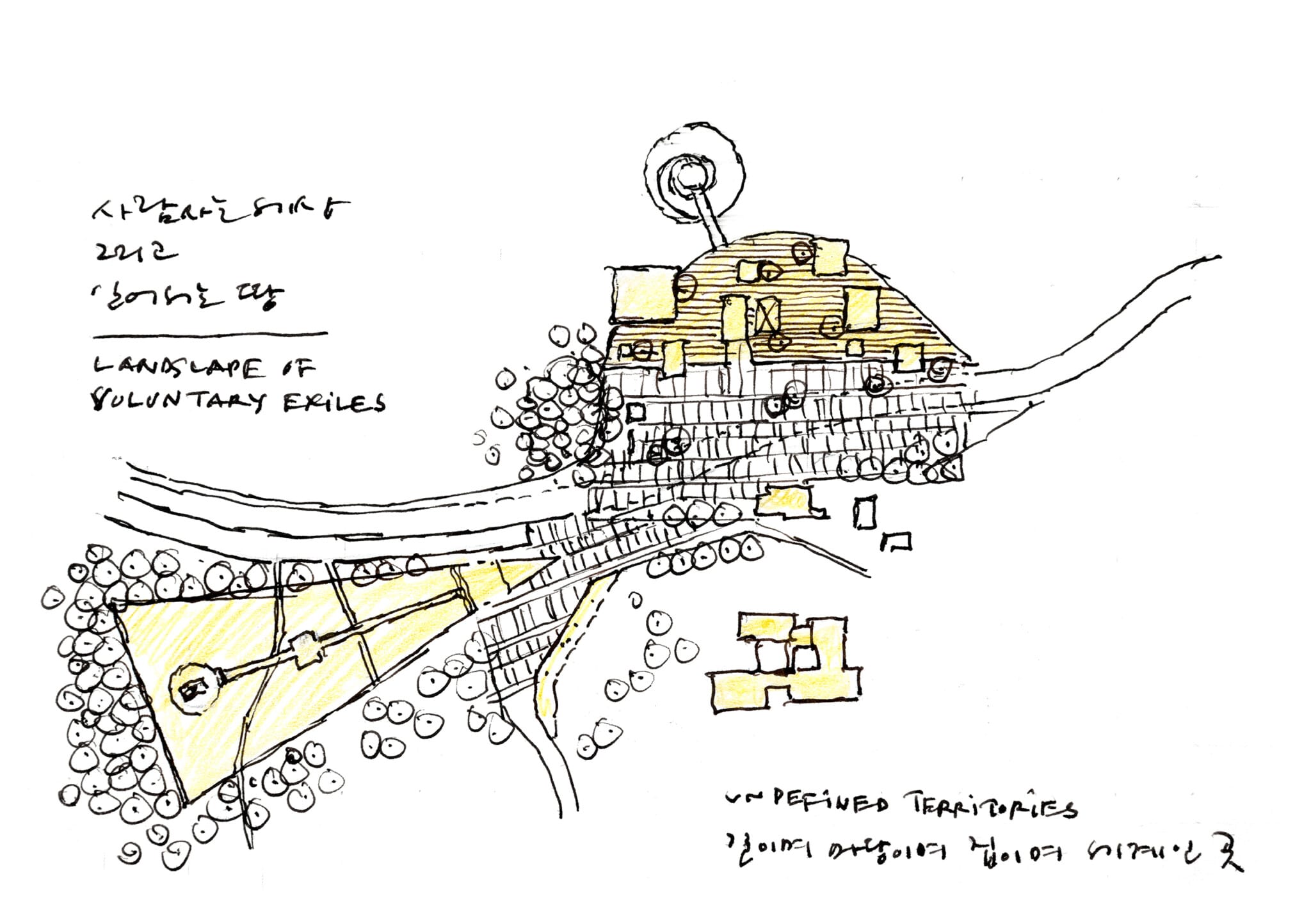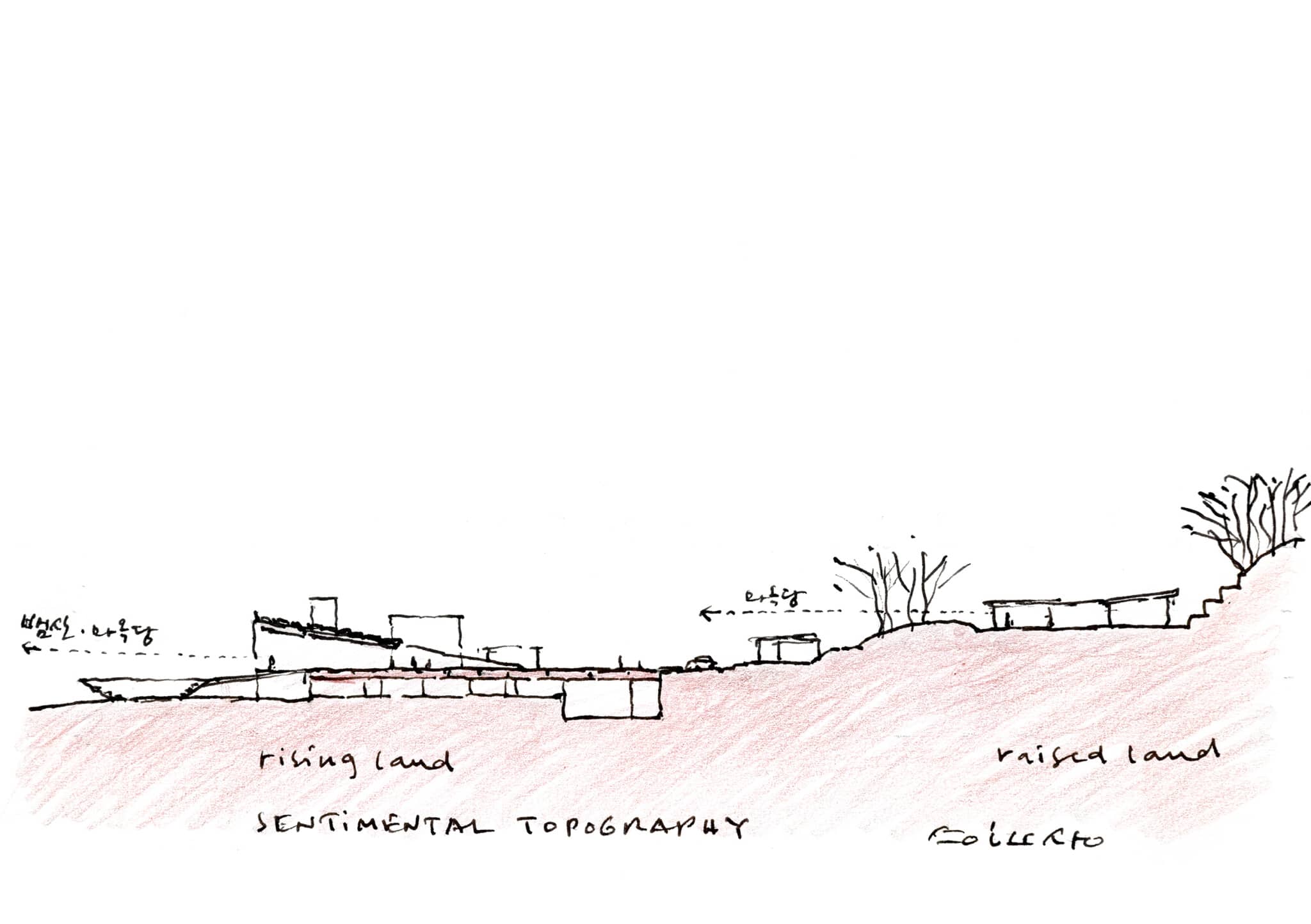President Roh Moo-Hyun Memorial
| 완공년도 | 2022 |
| 위치 | 경상남도 봉하 |
| 대지면적 | 119,287.00m2 |
| 건축면적 | 4,049.27m2 |
| 연면적 | 4,438.77m2 |
| Structural engineer | 더나은 구조 |
| Mechanical engineer | 디이테크 |
| Electrical engineer | 우림 전기 |
| Contractor | 부성건설, 영조건설 |
| Lighting design | 뉴라이트 |
| Landscape | 서안 |
| 완공년도 | 2022 |
| 위치 | 경상남도 봉하 |
| 대지면적 | 119,287.00m2 |
| 건축면적 | 4,049.27m2 |
| 연면적 | 4,438.77m2 |
| Structural engineer | 더나은 구조 |
| Mechanical engineer | 디이테크 |
| Electrical engineer | 우림 전기 |
| Contractor | 부성건설, 영조건설 |
| Lighting design | 뉴라이트 |
| Landscape | 서안 |
일어서는 땅
기념관이라고 하면 대개 스펙터클한 이미지를 떠올리는 경우가 많다. 더구나 한 시대 권력의 정점에 있었던 대통령을 기리는 기념관은 그 대통령에 대한 평가가 어떠하든 ‘기념비적’으로 세우는 게 또한 보통이었다. 예를 들면, 주변을 압도할 듯한 크기와 신전 같은 건축… 이런 건축을 가리켜 스펙터클하다고 하며, 미개한 사회일수록 그 위용은 더욱 크다. 『스펙터클의 사회』라는 책을 쓴 철학자 기 드보르는 ‘스펙터클은 종교적 환상의 물질적 재구성’이라고 단언한다. 또한, ‘기만과 허위라는 공통의 기반 위에 서는 이들은 역사와 기억을 마비시키는 사회 조직’이라 평가하며 ‘보이지 않는 폭력’이라고 까지 비난했다. 노무현 대통령의 가치는 결단코 그럴 수 없는 것이다. 그러니 노무현 대통령 기념관은 기존의 관념을 떠나는 새로운 개념의 기념관이어야 했으며 이는 노무현의 가치를 먼저 거론하는 데에서 출발한다.
기념관이 들어서는 땅 봉하마을에는 노무현 대통령의 생가가 이미 복원되어 있고, 짧은 기간이었다 해도 거주했던 사저가 있으며 마을 건너편에는 젊은 시절 공부한 ‘마옥당’도 있다. 거기에다가 우리 모두를 충격에 몰아넣은 부엉이바위의 절벽이 여전히 우뚝 서 있고, 결국 노무현 대통령의 묘역까지 있으니 이보다 더 확실한 기념적 장소와 시설이 있을까? 사실상 봉하마을 전역이 기념관인데, 여기서 새로운 기념관 건축은 그 형상을 아무리 기념적으로 만든다고 해도 더 큰 진정성이 있을 수 없다. 따라서, 각기 존재하는 이 모든 시설을 새로 짓는 기념관이 매개하여 하나로 묶는 역할을 감당하게 한다면, 이는 기념관이 존재해야 할 중요한 이유가 된다.
또 하나의 중요한 전제가 있다. 봉하마을의 공간이나 기존 건물의 규모는 그 크기가 죄다 작은 조직으로 되어 있어, 1천 평이 넘는 기념관이 하나의 건물로 마을에 들어서면 주변을 압도할 게 틀림없다. 그래서 이 건물은 또 다른 건축이 아니라 전체 풍경의 일부로 만들어져야 하며, 혹시 시설로 나타나게 되는 부분은 그 크기가 크지 않아야 한다는 전제가 당연하다.
현실적으로는 새로운 공간의 수요가 있었다. 원래 작은 마을이었던 이곳에 1년에 100만 명이 찾아오니 이들을 수용할 공간이 있을 리 없다. 사람들이 모일 수 있는 공간은 묘역 위에 조성한 공원인데, 이곳은 녹지로 보존되어야 해서 평상시에 사람들이 자유로이 모일 적절한 공간이 필요했다. 그래서 건물로서가 아니라 광장으로서의 기념관이 구상되었고 그 광장은 계단식의 경사진 형태로 나타나 여러 가지 행사에도 대응하게 하고, 그 하부에 필요한 내부 기능을 수용하게 했다.
이 경사진 광장의 가운데를 뚫은 출입문을 열고 들어가면 봉하 들녘이 펼쳐지고, 들녘 너머 뱀산이 부드러운 실루엣을 형성하며 달리고 있다. 한 층 아래에는 전시실이 있어 대통령의 생애와 업적에 관한 기억을 생생하게 되살릴 것인데, 지면에서 내려왔지만 곳곳에 외부로 연결되는 정원이 있어 들녘의 공간에 서 있는 느낌이 든다. 전시 관람을 마친 후에는 밖으로 나와 경사진 광장을 오르면 다시 봉하 들녁과 부엉이바위와 사자바위의 봉화산 줄기를 보게 되며 그 아래에 봉하마을이 이어진다. 경사진 광장의 여기저기에 솟은 매스는 내부의 공간이 확장된 것인데, 그 크기는 봉하마을의 기존 집들 크기와 비슷하여 마을이 연장되어 나타난 풍경으로 여겨질 터이다.
계단식으로 경사진 이 광장은 녹지도 있고 나무도 심어져서 편안히 앉아 쉴 수 있는 곳이기도 하고 관람석이기도 하다. 이 공간은 길가의 평탄한 광장과 이어져 있으며 건너편 사저와 생가의 영역을 아우르며 매개한다. 같은 포장으로 된 차도까지 포함하면 이 광장은 넓은 크기가 되어, 큰 행사를 할 수 있는 무대가 되고 마당이 된다. 수많은 모임과 행위가 수시로 펼쳐져 봉하마을의 중심 광장 혹은 한마당이 될 것으로 기대한다.
결론적으로 말하면 새롭게 건축된 기념관은 마당에 이어진 경사진 광장의 풍경이다. 마치 땅이 일어선 듯하다. 그래서 이 기념관 프로젝트를 “일어서는 땅”(Rising Land)라고 이름하였다. 일어선 땅. 우리 사회의 기층을 이루는 시민들이 깨어나 조직된 힘을 갖추는 게 민주주의 최후의 보루라고 역설하며 기층 민중에 대한 희망을 놓지 않았던 대통령의 가치와 같은 것이라고 믿었다.
Rising Land,
President Roh Moo-Hyun Memorial
When we think of a memorial, we usually think of a spectacular image. Moreover, it is also a common practice for a memorial to commemorate a president, who was at the peak authority of an era, to erect something ‘monumental’ no matter what the evaluation of the president. For example, the overwhelming scale and temple-like architecture is said to be spectacular and this gets greater in less civilized society. Philosopher Guy Debord, the author of ‘The Society of the Spectacle’ asserts that ‘The spectacle is the material reconstruction of the religious illusion.’ In addition, ‘Standing on the common ground of deception and falsehood, they are a social organization that paralyzes history and memory.’ he wrote and said the spectacle is an ‘invisible violence’. The value of President Roh Moo-Hyun is absolutely not as such. The Memorial Hall for President Roh Moo-Hyun had to be a memorial with a new concept that departs from the existing notions, and this has commenced by discussing the value of Roh Moo-Hyun first.
Bongha village, where the site for the memorial is located, has restored the birth place of President Roh Moo-Hyun and has a private residence where he lived though for a short period of time, and across the village, there is also ‘Maokdang’, where he studied when he was young. In addition to that, the cliff of Owl Rock, which shocked us all, still stands tall, and there is even the graveyard of President Roh Moo-Hyun. Could there be a more definitive commemorative place and facility than this? In fact, the entire Bongha village is a memorial, and the construction of a new memorial architecture here cannot have greater authenticity, no matter how commemorative the shape is. Therefore, if the newly built memorial plays the role of tying together all these existing facilities, this becomes an important reason for the existence of the memorial.
There is another important premise. The space and the scale of the existing buildings of Bongha village is rather small, and no doubt the approximately three thousand sqm single memorial building would overwhelm the surroundings. It is natural that the memorial building be designed as a part of the overall landscape rather than another architecture, and that the appearing facility should not be large in size.
In reality, there was a demand for a new space in order to accommodate 1 million visitors per year in this small village. A space for people to gather was designed as a park above the graveyard, but it had to be preserved as a greenery. Therefore there still was a need for people to gather freely and hence the memorial was conceived as a public square rather than a building, the square became in the form of sloping steps which will respond to various events and to contain necessary internal functions below the steps.
When one walks into the entrance foyer through the central cut of the sloping square, one can witness the Bongha fields spreaded across at the skirt of the soft silhouette of the Snake Mountain. There are exhibition rooms below the entrance level where the memories of the president’s life and achievements will revive. Although the exhibition rooms are located below the ground level, there are atriums that connects the space to outside allowing one to feel as if they are standing in the level of the field. After viewing the exhibition and exiting the building, one can climb the sloping stepped square to see Bongha field, Owl Rock, and Lion Rock along the Bonghwasan Mountain, and back to Bongha village running below. The mass rising here and there on top of the sloping square is an extension of the inner space, and its size is similar to the size of the existing houses in the village, so for it to be considered as an extended landscape of the village.
The sloping stepped square has greenery and trees with places to sit down and rest, as well as it can play as an auditorium. This space is connected to the flat square by the street, mediating by encompassing the areas of the private residence and the birthplace on the street across. When including the street, the square becomes a large stage or a huge courtyard. It is expected that numerous gatherings and activities will be held frequently and take the role of the central space in the Bongha village.
In conclusion, the newly built memorial hall is a landscape of a sloping square connected to the flat square space. It is as if the ground has risen, hence the project was named ‘Rising land’. Rising land, as per the value of the president, who emphasized that the last bastion of democracy is for the awaken citizens of the base of our society to equip themselves with organized power, he did not give up hope for the people of the lower classes.








